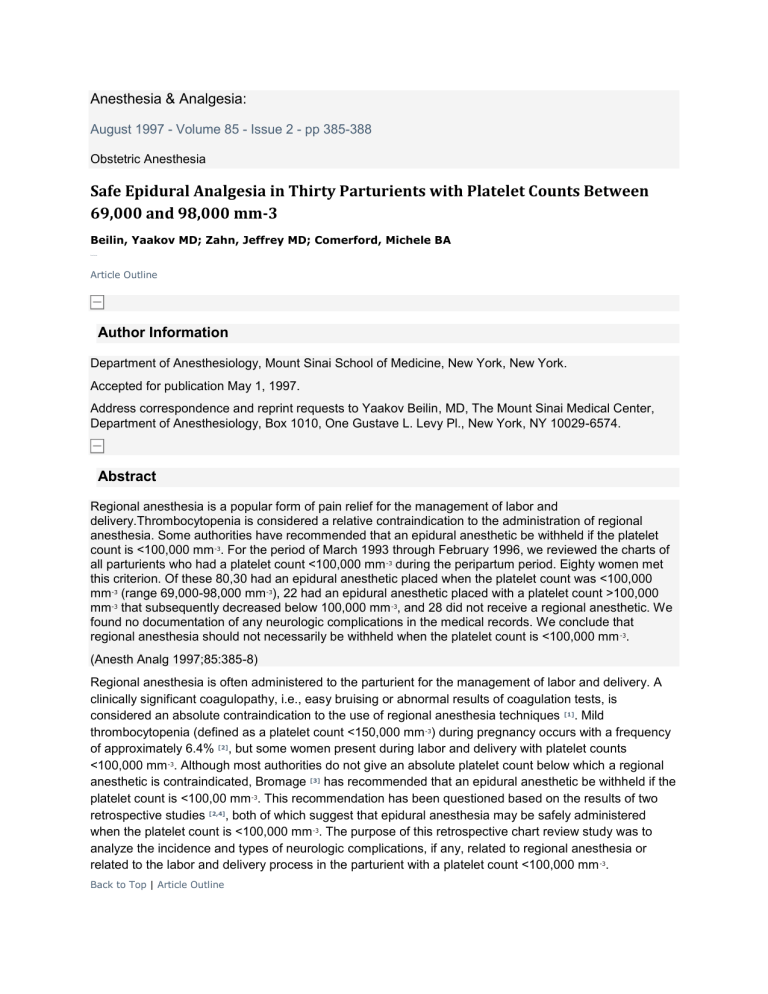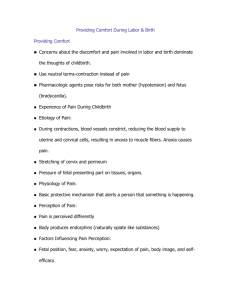The safety of initiating an epidural anesthetic - dan

Anesthesia & Analgesia:
August 1997 - Volume 85 - Issue 2 - pp 385-388
Obstetric Anesthesia
Safe Epidural Analgesia in Thirty Parturients with Platelet Counts Between
69,000 and 98,000 mm-3
Beilin, Yaakov MD; Zahn, Jeffrey MD; Comerford, Michele BA
Free Acc ess
Article Outline
Author Information
Department of Anesthesiology, Mount Sinai School of Medicine, New York, New York.
Accepted for publication May 1, 1997.
Address correspondence and reprint requests to Yaakov Beilin, MD, The Mount Sinai Medical Center,
Department of Anesthesiology, Box 1010, One Gustave L. Levy Pl., New York, NY 10029-6574.
Abstract
Regional anesthesia is a popular form of pain relief for the management of labor and delivery.Thrombocytopenia is considered a relative contraindication to the administration of regional anesthesia. Some authorities have recommended that an epidural anesthetic be withheld if the platelet count is <100,000 mm -3 . For the period of March 1993 through February 1996, we reviewed the charts of all parturients who had a platelet count <100,000 mm -3 during the peripartum period. Eighty women met this criterion. Of these 80,30 had an epidural anesthetic placed when the platelet count was <100,000 mm -3 (range 69,000-98,000 mm -3 ), 22 had an epidural anesthetic placed with a platelet count >100,000 mm -3 that subsequently decreased below 100,000 mm -3 , and 28 did not receive a regional anesthetic. We found no documentation of any neurologic complications in the medical records. We conclude that regional anesthesia should not necessarily be withheld when the platelet count is <100,000 mm -3 .
(Anesth Analg 1997;85:385-8)
Regional anesthesia is often administered to the parturient for the management of labor and delivery. A clinically significant coagulopathy, i.e., easy bruising or abnormal results of coagulation tests, is considered an absolute contraindication to the use of regional anesthesia techniques [1] . Mild thrombocytopenia (defined as a platelet count <150,000 mm -3 ) during pregnancy occurs with a frequency of approximately 6.4% [2] , but some women present during labor and delivery with platelet counts
<100,000 mm -3 . Although most authorities do not give an absolute platelet count below which a regional anesthetic is contraindicated, Bromage [3] has recommended that an epidural anesthetic be withheld if the platelet count is <100,00 mm -3 . This recommendation has been questioned based on the results of two retrospective studies [2,4] , both of which suggest that epidural anesthesia may be safely administered when the platelet count is <100,000 mm -3 . The purpose of this retrospective chart review study was to analyze the incidence and types of neurologic complications, if any, related to regional anesthesia or related to the labor and delivery process in the parturient with a platelet count <100,000 mm -3 .
Back to Top | Article Outline
Methods
After approval from our institutional review board, we used the laboratory information system at The
Mount Sinai Hospital in New York City to identify patients from March 1, 1993 through February 29, 1996 who had a platelet count <100,000 mm ( -3 ) during the peripartum period. It is our routine that upon admission to the labor floor, all parturients have a blood specimen sent to the hematology laboratory for determination of a complete blood count with platelets. A Coulter counter (Coulter[registered sign] STKS,
Coulter Corporation, Hialeah, FL) is used to determine all platelet counts, which it can accomplish within
45 s. The labor and delivery suite can receive the results within 5 min of sending the specimen. The
Coulter counter is very accurate, even at low platelet counts, with a specified coefficient of variation of
<3.3% at a platelet count of 300,000 mm -3 and <6.6% at a platelet count of 30,000 mm ( -3 ).
For each chart reviewed, the etiology of thrombocytopenia (e.g., preeclampsia, idiopathic thrombocytopenic purpura, infection, or thrombocytopenia of pregnancy), type of anesthesia (epidural, spinal, general, or none), mode of delivery (vaginal, forceps assisted, or cesarean section), and complications (neurologic deficits or paralysis) were noted.
The epidural anesthetics were administered by multiple anesthesiologists, both resident and attending physicians, but all were administered by using the same epidural kit (Perifix[registered sign] Continuous
Epidural Anesthesia Tray, B. Braun Medical, Inc., Bethlehem, PA). The epidural kit includes an 18-gauge
Hustead needle and a 20-gauge multiorifice catheter. The epidural catheters were placed via a midline approach at the L2-3 or L3-4 interspace using the loss of resistance to air technique with the woman in either the sitting or the lateral decubitus position. The local anesthetic used for labor analgesia was bupivacaine 0.25% boluses followed by an infusion of bupivacaine 0.125%. Lidocaine 2% with 1:200,000 epinephrine was used for cesarean section.
Back to Top | Article Outline
Results
During the period under review, 15,919 women presented for labor and delivery, of whom 80 (0.50%) had platelet counts <100,000 mm -3 during the peripartum period. Of these 80, 30 (Group 1) had an epidural anesthetic placed at when the platelet count was <100,000 mm -3 ( Table 1 ), 22 (Group 2) had an epidural anesthetic placed when the platelet count was >100,000 mm -3 but whose platelet count subsequently decreased below 100,000 mm -3 ( Table 2 ), and 28 (Group 3) did not receive a regional anesthetic ( Table
3 ). No woman had a spinal anesthetic.
Table 1
Image
Tools
Table 2
Image
Tools
Table 3
Image
Tools
The range of platelet counts in Group 1 at the time of epidural placement was 69,000-98,000 mm -3 . The lowest recorded platelet count for each woman in Group 2 was 58,000-99,000 mm -3 . The range of platelet counts in Group 3 at the time of delivery was 28,000-94,000 mm -3 .
The reasons cited in the medical record for not placing an epidural anesthetic in the Group 3 women was either a decreasing platelet count (n = 5), evidence of bruising (n = 2), the absolute platelet count was
"too low" (n = 11), or the patient also had another abnormal test of coagulation, e.g., a prolonged partial thromboplastin time (n = 4). The range of platelet counts in the women in whom the anesthesiologist considered the platelet count too low to place an epidural anesthetic was 34,000-90,000 mm -3 . An anesthesiologist was not consulted to administer an anesthetic for six women.
No patient in any of the three groups had any documented neurologic complication.
Back to Top | Article Outline
Discussion
The development of an epidural or subdural hematoma after the placement of a spinal or epidural anesthetic is rare [5] but is generally associated with patients who have disorders of coagulation. To our knowledge, there are only two case reports of subdural hematoma occurring in the parturient who had regional anesthesia, and only one was related to a coagulopathy. This woman had preeclampsia, a lupus anticoagulant, and a prolonged partial thromboplastin time [6] . The other case was that of a woman who had a preexisting spinal pathology, an ependymoma [7] .
Platelets play an important role in the hemostatic system. They initiate the hemostatic process by aggregating and forming a plug, and the entire coagulation cascade occurs on the platelet membrane.
Tests of platelet function include the bleeding time test, thromboelastography and aggregometry, or flow cytometry.
The bleeding time test is a simple bedside test that evaluates a combination of both the quality and quantity of the platelets. This test, however, is no longer considered useful to determine the safety of epidural catheter placement because it does not necessarily reflect the risk of bleeding at other sites [8,9] and because there is wide observer variation [10] .
The thromboelastogram can measure all phases of coagulation and fibrinolysis in a single sample of blood. There is no evidence, however, that a normal thromboelastogram can determine the safety of epidural anesthesia, although some researchers hope that it can be used in this fashion.
1
( 1 ) Chadwick HS, Wall MH, Chandler W, Ross BK. Thromboelastography in mild and severe preeclampsia
[abstract]. Anesthesiology 1993;79:A992.
Aggregometry measures the ability of platelets to aggregate in response to specific protein agonists, while flow cytometry measures platelet activation and function [11] . Neither test, however, is a practical clinical test, as both require too much time and the availability of a basic science laboratory for their performance.
The minimum platelet count below which it is safe to place a regional anesthetic is unknown. Bromage [3] has recommended not placing an epidural anesthetic in any patient whose platelet count is <100,000 mm -
3 . Other authors do not define a minimum platelet count but are similarly cautious [12,13] . Based on the results of a survey by Beilin et al. [14] , most anesthesiologists (66% of those in academic practice and 55% of those in private practice) will place an epidural anesthetic when the platelet count is between 80,000 and 100,000 mm -3 .
The safety of initiating an epidural anesthetic when the platelet count is <100,000 mm -3 is supported by the results of two retrospective studies. Rolbin et al. [2] reviewed the platelet counts of 2204 randomly selected parturients. They found three women with a platelet count <100,000 mm -3 who received epidural anesthesia without neurolgic sequelae. Rasmus et al. [4] reviewed the records of 2929 consecutive parturients for peripartum thrombocytopenia. They found 24 women whose platelet count was <100,000 mm -3 . Of these 24, 5 had an epidural anesthetic placed when the platelet count was <100,000 mm -3 , all without sequelae. In addition, there is one case report [15] of a woman who safely received an epidural anesthetic with a platelet count of 2000 mm -3 .
We report the largest series of parturients who had an epidural anesthetic placed without complications when the platelet count was <100,000 mm -3 . The incidence of thrombocytopenia in our study (0.50%) is within the range reported in other studies [2,4] . In a large hospital with 5,000 deliveries per year, approximately 25 women per year present during labor with a platelet count <100,000 mm -3 . To deny
epidural anesthesia to a woman because of an arbitrary value for platelet count may be detrimental to her health, especially if she has an underlying condition such as preeclampsia [16] , or if she requires general anesthesia and has an anticipated difficult airway.
We also report the largest series of women who had a peripartum platelet count <100,000 mm -3 , none of whom had any documented postpartum neurologic problem. It is certainly possible that some subtle neurologic deficits may have gone undetected or may not have been recorded in the chart. Ong et al. [17] attempted to identify the incidence of neurologic deficits in 23,287 parturients by reviewing their medical records and interviewing them by telephone. They found a low rate of neurologic deficits in all parturients
(18.9 of 10,000), with the highest rate in those who had received an epidural anesthetic (36.2 of 10,000) or a general anesthetic (34.7 of 10,000). All deficits were transient, with recovery within 72 h. They also found that almost 78% of the deficits were not documented in the patient's medical record but were only found during the telephone interview. However, it is highly unlikely that we missed any major neurologic catastrophes such as an epidural hematoma, which would require surgical decompression to treat.
The 30 women in our series who safely received an epidural anesthetic with a platelet count <100,000 mm -3 had certain characteristics in common. No woman had a decreasing platelet count around the time of epidural catheter placement, and no woman had any clinical evidence of bleeding; however, five women were denied an epidural anesthetic because of a decreasing platelet count and two because of evidence of bruising. It is our practice that if a woman presents in labor with a low platelet count (i.e., close to 100,000 mm -3 ), we obtain at least one additional count as close in time to epidural placement as possible to assure that it is not decreasing further. This is especially important in dynamic conditions such as idiopathic thrombocytopenia or preeclampsia.
We also do not consider the use of aspirin and other antiplatelet medications a contraindication to epidural analgesia. Horlocker et al. [18] reviewed the charts of 805 orthopedic patients. They found 391 patients who were receiving an antiplatelet medication, and all received either a spinal or epidural anesthetic without neurologic sequelae [18] . There is also a large, prospective, randomized, double-blind study of the effect of aspirin on the incidence and sequelae of preeclampsia. Through January 1991,
1069 women who were taking aspirin 60 mg per day had an epidural anesthetic for their delivery without neurologic sequelae [19] .
If the decision is made to proceed with the regional anesthetic, we recommend using the lowest concentration of local anesthetic necessary to produce analgesia while preserving motor function. The patient should be examined every one to two hours to assess the extent of the motor block, and these examinations should continue until after the anesthetic has worn off and the catheter has been removed.
In this way, if the patient develops a motor block out of proportion to what one would expect, or if the anesthetic has a prolonged duration of action, the patient can be immediately assessed using computed tomography or magnetic resonance imaging. Immediate assessment is necessary, because if the patient has an epidural hematoma, an emergent laminectomy and decompression must be performed within 6-12 hours if possible, to preserve neurologic function [20] .
The size of the sample in this study is not large enough to support the claim that regional anesthesia in women with a platelet count <100,000 mm -3 is safe. Using accepted nomograms for interpretation of zero numerators, we can say with 95% confidence that the incidence of adverse outcomes is no greater than
10% under the conditions of this study [21] . Unfortunately, the large prospective studies that are needed to definitively answer this question cannot be accomplished practically. Assuming that the incidence of epidural hematoma in patients with a platelet count >100,000 mm -3 is 1:10,000, a conservative estimate, then to detect a doubling of that incidence in patients with a lower platelet count would require study of more than 200,000 patients. It is our recommendation that a patient's entire clinical presentation should be taken into account when deciding on the appropriate anesthetic technique.
The authors express appreciation to James B. Eisenkraft, MD, Professor of Anesthesiology, and to
Andrew B. Leibowitz, MD, Assistant Professor of Anesthesiology and Surgery at The Mount Sinai Medical
Center, New York, NY for their critical review of this manuscript, and to Carol Bodian, DrPH, for her help with the statistical analyses.
Back to Top | Article Outline
REFERENCES
1. Shnider SM, Levinson G, Ralston DH. Regional anesthesia for labor and delivery. In: Shnider SM,
Levinson G, eds. Anesthesia for obstetrics. 3rd ed. Baltimore: Williams & Wilkins, 1993:150.
Cited Here...
2. Rolbin SH, Abbott D, Musclow E, et al. Epidural anesthesia in pregnant patients with low platelet counts. Obstet Gynecol 1988;71:918-20.
Cited Here...
| View Full Text | PubMed
3. Bromage PR. Neurologic complications of regional anesthesia for obstetrics. In: Shnider SM, Levinson
G, eds. Anesthesia for obstetrics. 3rd ed. Baltimore: Williams & Wilkins, 1993:443-4.
Cited Here...
4. Rasmus KT, Rottman RL, Kotelko DM, et al. Unrecognized thrombocytopenia and regional anesthesia in parturients: a retrospective review. Obstet Gynecol 1989;73:943-6.
Cited Here...
| View Full Text | PubMed
5. Odoom JA, Sih IL. Epidural analgesia and anticoagulant therapy: experience with one thousand cases of continuous epidurals. Anaesthesia 1983;38:254-9.
Cited Here...
| PubMed | CrossRef
6. Lao TT, Halpern SH, MacDonald D, Huh C. Spinal subdural hematoma in a parturient after attempted epidural anaesthesia. Can J Anaesth 1993;40:340-5.
Cited Here...
| PubMed | CrossRef
7. Roscoe MWA, Barrington TW. Acute spinal subdural hematoma: a case report and review of literature.
Spine 1984;9:672-5.
Cited Here...
| View Full Text | PubMed | CrossRef
8. Lind SE. The bleeding time does not predict surgical bleeding. Blood 1991;77:2547-52.
Cited Here...
| PubMed
9. Channing Rodgers RP, Levin J. A critical reappraisal of the bleeding time. Sem Thromb Hemostas
1990;16:1-10.
Cited Here...
10. O'Kelly SW, Lawes EG, Luntley JB. Bleeding time: is it a useful clinical tool? Br J Anaesth
1992;68:313-5.
Cited Here...
11. Turner ML, Ludlam CA. Haemostatic disorders which may complicate pregnancy: the haematological management. In: Greer IA, Turpie AGG, Forbes CD, eds. Haemostasis and thrombosis in obstetrics and gynaecology. London: Chapman & Hall Medical, 1992:105.
Cited Here...
12. Rocke DA, Rout CC, Orlikowski CEP. Anesthesia and coexisting maternal disease. In: Norris MC, ed.
Obstetric anesthesia. Philadelphia: JB Lippincott, 1993:460-1.
Cited Here...
13. Lechner RB. Hematologic and coagulation disorders. In: Chestnut DH, ed. Obstetric anesthesia: principles and practice. St. Louis, MO: Mosby, 1994:827-8.
Cited Here...
14. Beilin Y, Bodian CA, Haddad EM, Leibowitz AB. Practice patterns of anesthesiologists regarding situations in obstetric anesthesia where clinical management is controversial. Anesth Analg 1996;83:735-
41.
Cited Here...
| View Full Text | PubMed | CrossRef
15. Hew-Wing P, Rolbin SH, Hew E, Amato D. Epidural anaesthesia and thrombocytopenia. Anaesthesia
1989;44:775-7.
Cited Here...
| PubMed | CrossRef
16. Jouppila P, Jouppila R, Hollmen A, Koivula A. Lumbar epidural analgesia to improve intervillous blood flow during labor in severe preeclampsia. Obstet Gynecol 1982;59:158-61.
Cited Here...
| View Full Text | PubMed
17. Ong BY, Cohen MM, Esmail A, et al. Paresthesias and motor dysfunction after labor and delivery.
Anesth Analg 1987;66:18-22.
Cited Here...
| View Full Text | PubMed | CrossRef
18. Horlocker TT, Wedel DJ, Offord KP. Does preoperative antiplatelet therapy increase the risk of hemorrhagic complications associated with regional anesthesia? Anesth Analg 1990;70:631-4.
Cited Here...
| View Full Text | PubMed | CrossRef
19. De Swiet M, Redman CWG. Aspirin, extradural anaesthesia and the MRC collaborative low dose aspirin study in pregnancy (CLASP). Br J Anaesth 1992;69:109-10.
Cited Here...
20. Stephanov S, de Preux J. Lumbar epidural hematoma following epidural anesthesia. Surg Neurol
1982;18:351-3.
Cited Here...
| PubMed | CrossRef
21. Hanley JA, Lippman-Hand A. If nothing goes wrong, is everything all right? Interpreting zero numerators. JAMA 1983;249:1743-5.
Cited Here...
| PubMed | CrossRef
Cited By:
This article has been cited 2 time(s).
Revista Latinoamericana De Hipertension
Serum nitrite-nitrate in pregnant women with gestational hypertension and in patients with uncomplicated pregnancies
Sosa-Canache, BA; Barreto, KBC; Balza, ACD; Hernandez-Hernandez, R
Revista Latinoamericana De Hipertension , 7(1): 1-6.
Hematology-American Society Hematology Education Program
Thrombocytopenia in pregnancy: is this immune thrombocytopenia or ... ?
Gernsheimer, TB
Hematology-American Society Hematology Education Program , (): 198-202.
10.1182/asheducation-2012.1.198
CrossRef
Back to Top | Article Outline
© 1997 International Anesthesia Research Society







